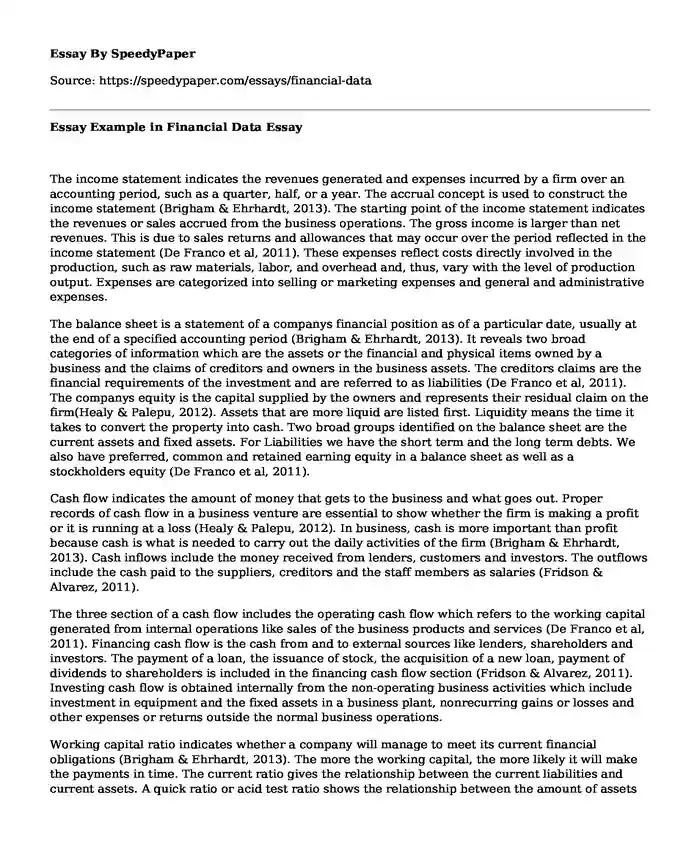The income statement indicates the revenues generated and expenses incurred by a firm over an accounting period, such as a quarter, half, or a year. The accrual concept is used to construct the income statement (Brigham & Ehrhardt, 2013). The starting point of the income statement indicates the revenues or sales accrued from the business operations. The gross income is larger than net revenues. This is due to sales returns and allowances that may occur over the period reflected in the income statement (De Franco et al, 2011). These expenses reflect costs directly involved in the production, such as raw materials, labor, and overhead and, thus, vary with the level of production output. Expenses are categorized into selling or marketing expenses and general and administrative expenses.
The balance sheet is a statement of a companys financial position as of a particular date, usually at the end of a specified accounting period (Brigham & Ehrhardt, 2013). It reveals two broad categories of information which are the assets or the financial and physical items owned by a business and the claims of creditors and owners in the business assets. The creditors claims are the financial requirements of the investment and are referred to as liabilities (De Franco et al, 2011). The companys equity is the capital supplied by the owners and represents their residual claim on the firm(Healy & Palepu, 2012). Assets that are more liquid are listed first. Liquidity means the time it takes to convert the property into cash. Two broad groups identified on the balance sheet are the current assets and fixed assets. For Liabilities we have the short term and the long term debts. We also have preferred, common and retained earning equity in a balance sheet as well as a stockholders equity (De Franco et al, 2011).
Cash flow indicates the amount of money that gets to the business and what goes out. Proper records of cash flow in a business venture are essential to show whether the firm is making a profit or it is running at a loss (Healy & Palepu, 2012). In business, cash is more important than profit because cash is what is needed to carry out the daily activities of the firm (Brigham & Ehrhardt, 2013). Cash inflows include the money received from lenders, customers and investors. The outflows include the cash paid to the suppliers, creditors and the staff members as salaries (Fridson & Alvarez, 2011).
The three section of a cash flow includes the operating cash flow which refers to the working capital generated from internal operations like sales of the business products and services (De Franco et al, 2011). Financing cash flow is the cash from and to external sources like lenders, shareholders and investors. The payment of a loan, the issuance of stock, the acquisition of a new loan, payment of dividends to shareholders is included in the financing cash flow section (Fridson & Alvarez, 2011). Investing cash flow is obtained internally from the non-operating business activities which include investment in equipment and the fixed assets in a business plant, nonrecurring gains or losses and other expenses or returns outside the normal business operations.
Working capital ratio indicates whether a company will manage to meet its current financial obligations (Brigham & Ehrhardt, 2013). The more the working capital, the more likely it will make the payments in time. The current ratio gives the relationship between the current liabilities and current assets. A quick ratio or acid test ratio shows the relationship between the amount of assets that can easily be turned into cash and the current liabilities after excluding the inventory, supplies, and prepaid expenses.
References
Brigham, E., & Ehrhardt, M. (2013). Financial management: Theory & practice. Cengage Learning.
De Franco, G., Kothari, S. P., & Verdi, R. S. (2011). The benefits of financial statement comparability. Journal of Accounting Research, 49(4), 895-931.
Fridson, M. S., & Alvarez, F. (2011). Financial statement analysis: a practitioner's guide (Vol. 597). John Wiley & Sons.
Healy, P., & Palepu, K. (2012). Business Analysis Valuation: Using Financial Statements. Cengage Learning.
Cite this page
Essay Example in Financial Data. (2019, Sep 20). Retrieved from https://speedypaper.net/essays/financial-data
Request Removal
If you are the original author of this essay and no longer wish to have it published on the SpeedyPaper website, please click below to request its removal:
- Essay Example on the Operational Excellence of Capitec Bank
- Free Essay Containing Critical Thinking Exercise on Physical Aggression
- Free Essay on Organizational Citizenship
- Religion Essay Example: Reason and Rationale for the Canonical Scriptures
- Essay Example on Revenue Cycle
- Turning a Blind Eye to Genocide and Related Stories, Essay Sample
- Paper Example: The Canadian and US Healthcare Systems
Popular categories





